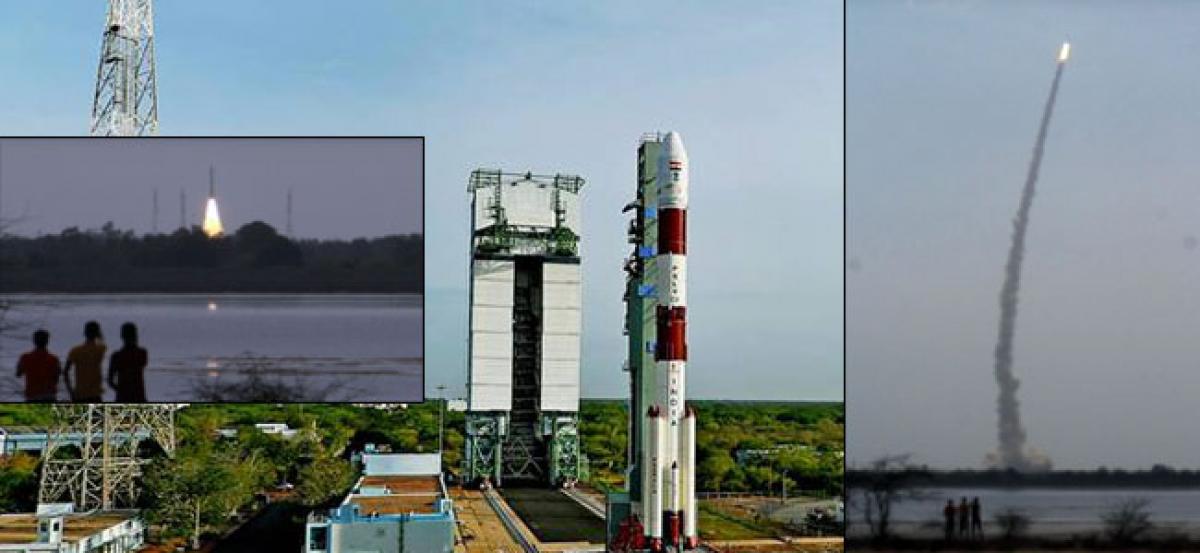Live
- Wanaparthy collector reviews on survey of welfare schemes
- NDRF, NDA always come to rescue in case of disasters
- ‘Bhairavam’ teaser is just around the corner
- ‘Shiva Sambho’ blends culture and devotion in Telugu cinema
- Akash Jagannadh extends generous support to veteran Actress Pavala Syamala
- 'Attack' on Kejriwal: Atishi claims BJP wants to harm ex-CM, Parvesh hits back
- Amit Shah emphasizes Centre's commitment to AP development
- Bangladeshi angle in Saif Ali Khan stabbing case raises political din
- CII pegs India's growth rate at 7 per cent for 2025-26 amid rising private investments
- Smith injures elbow ahead of for SL tour, Kuhnemann nursing thumb surgery
Just In

In yet another multiple satellite launch, India on Friday successfully put into orbit its own earth observation satellite Cartosat, nano satellite NIUSAT and 29 foreign satellites from 14 countries.
Sriharikota (Andhra Pradesh): In yet another multiple satellite launch, India on Friday successfully put into orbit its own earth observation satellite Cartosat, nano satellite NIUSAT and 29 foreign satellites from 14 countries.
The rocket Polar Satellite Launch Vehicle's (PSLV) main cargo was India's 712 kg Cartosat-2 series satellite for earth observation with a design life of five years.
This satellite is similar to the earlier Cartosat-2 series.
The other 30 satellites weighing 243 kg were from 14 countries - Austria, Belgium, Britain, Chile, Czech Republic, Finland, France, Germany, Italy, Japan, Latvia, Lithuania, Slovakia, and the US - as well as one Indian nano satellite, NIUSAT.
The whole mission got over in around 23 minutes.
"The mission is successful. All the satellites are in the orbit," A.S. Kiran Kumar, Chairman of the Indian Space Research Organisation (ISRO), said after the launch.
Speaking about the GSAT-19 communication satellite launched early this month, Kumar said it had reached its designated orbit and all the payloads had been switched on.
He said that by the end of this month, one more communication satellite will be launched by India.
Kumar said ISRO will continue work on its earth observation, navigation and communication satellites.
According to ISRO officials, the organisation has accelerated the work on developing the semi-cryogenic engine to increase the carrying capacity of heavier rockets geosynchronous satellite launch.
M. Annadurai, Director, ISRO Satellite Centre, said the signals from the satellites launched by the PSLV rocket on Friday were good.
He said ISRO's satellite systems were getting compact.
According to ISRO, the images sent by Cartosat satellite would be useful for cartographic, urban, rural, coastal land use, utility management like road network monitoring, water distribution, creation of land use maps, change detection to bring out geographical and man-made features and various other land information systems and geographical information system applications.
One of the 30 co-passenger satellites is the Indian nano satellite 15 kg NIUSAT belonging to Nooral Islam University, Tamil Nadu.
The satellite will provide multi-spectral imagery for agricultural crop monitoring and disaster management support applications.
Exactly at 9.29 a.m., the PSLV rocket - 44.4 metres tall and weighing 320 tonnes - tore into the morning skies with fierce orange flames at its tail.
Gathering speed every second, the rocket raced towards the sky amidst the cheers of the ISRO officials and the media team assembled at the rocket port here.
The PSLV rocket is a four-stage engine rocket powered by solid and liquid fuel alternatively.
At the rocket mission control room, Indian space scientists were glued to their computer screens watching the rocket escaping the earth's gravitational pull.
Just over 16 minutes into the flight, the PSLV rocket ejected Cartosat at an altitude of around 510 km.
It was followed by NIUSAT and the 29 foreign satellites.

© 2025 Hyderabad Media House Limited/The Hans India. All rights reserved. Powered by hocalwire.com







